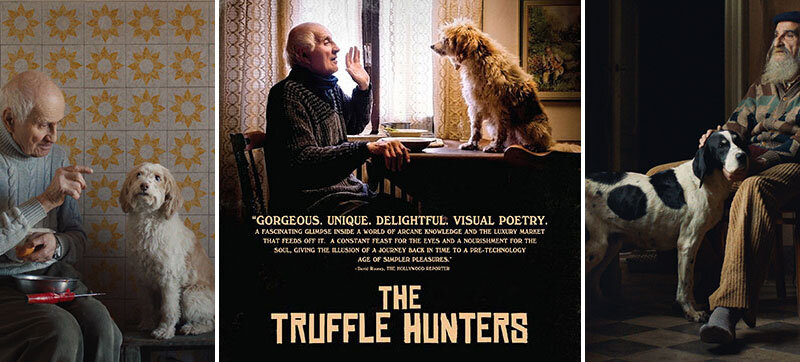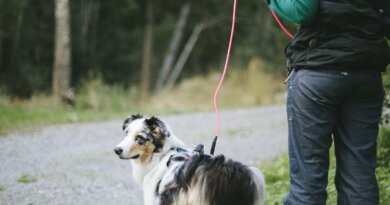Q&A with “The Truffle Hunters” filmmakers Michael Dweck and Gregory Kershaw
The Truffle Hunters opens with a gorgeous, contemplative long shot—a steep, thickly forested northwestern Italian hillside accented by its trees’ yellowing leaves and skeletal branches—that sets the tone for what’s to come. In the bottom of the frame, a person accompanied by a dog slowly emerges from the forest. It’s clear that the year is ending, that cold and snow are coming—an apt metaphor for the through-line that defines this documentary. A meditation on a group of elderly men and their devoted dogs engaged in an ancient activity that may be doomed by both modern life and climate change, it’s won awards from the Directors Guild of America and the American Society of Cinematographers, among others.
Filmmakers Michael Dweck and Gregory Kershaw mix footage of the search for the alba truffle with intimate scenes of domestic life, quiet examples of the deep bond shared by dogs and their people. Read on for insights into the documentary’s making, their motivations and, of course, the dogs, then go here for our review.
Bark: You’ve referred to the region where the film takes places as a fairy-tale kingdom, untouched by time and modernity. How did you come across it, how did you approach it, and why did you choose this arcane, mysterious activity?
Michael Dweck: We had finished The Last Race [a Sundance documentary depicting the Long Island birthplace of stock car racing] and needed a break, a place to disappear to in August. I went to a tiny village in northern Italy; coincidentally, Gregory had been in that exact same place three weeks earlier, although I didn’t know it.
GET THE BARK NEWSLETTER IN YOUR INBOX!
Sign up and get the answers to your questions.
We were asked, “Why aren’t you here in November?” or, in other words, during truffle season. When we tried to find out more about where the truffles came from, a shopkeeper told me, “All I know is, I put 50 euros in this little wooden box and the next morning, a white truffle appears in the box.”
We were hooked. We realized that there was a secret in these hills that we had to find out. We’re interested in communities that are steeped in tradition, and this one was very magical. We went back, off and on, for three years; the first year was spent letting the truffle hunters and their community get to know who we were.
In their homes, we were brought back in time. We observed how they lived, what they had for dinner, how and when they prepared to go out to look for truffles. We’d set the camera up, frame it beautifully, let it run for a couple of hours. We would sometimes only shoot one time a day, waiting for the right light.
Gregory Kershaw: One of the things we’ve held onto as documentarians is that a lot is about capturing a feeling—how do we translate that into a cinematic experience? For The Truffle Hunters, before we had our characters, before we knew what the story was, there was this feeling we talked about, and how we could translate it into a cinematic experience. That was the beauty of shooting over three years. We thought a lot about how we filmed it, and created a way to capture it that allowed us to disappear as filmmakers, to give the people we were filming a space to move around and be comfortable in. After a while, they would forget about us and go about their lives.
Bk: Did it take a lot of convincing to get the hunters to trust you?
GK: When we first started hearing about these truffle hunters, it was in whispers. Once we met the real truffle hunters [as opposed to the people who take tourists out to find planted truffles], we had to build that trust as well. These guys are guarding this incredible secret—truffles are worth almost as much as gold per ounce. They have knowledge they share only with their dogs, knowledge that it’s taken a lifetime or maybe generations to gain.
It took a lot of time to build trust within that community—it was a process of entering into it, which took about a year. It took two years of filming before we got to see where they found the real truffles.
MD: We had to pay our dues, out in the woods. They let us in slowly; eventually we were told, “I’m going out for truffles. You can follow me if you want.” The first time we went out, it was down a ravine that was probably 2,000 feet at a vertical decline, and we were carrying tripods and a really heavy camera. It was muddy and raining, and we’re sliding around. But we kept coming back and back—we’d be in three feet of snow, we’d be in mud … they walk at night sometimes, up to 15 to 20 miles in the dark.
Bk: The dogs seem to be a variety of breeds and mixes. How do the men determine which puppy will make a good truffle-hunting dog? How do they train them?
MD/GK: There’s a scene that didn’t make the film, where we were following the life cycle of a dog. They rub a truffle on the mom’s belly, and you start to be able to see which of the puppies are interested in it—in the smell and taste of the truffle. Eventually, you see that three or four of the litter have potential. Then they start training the puppies, which begins with gorgonzola cheese in a cup, and having them follow along in the tall grass. It takes up to three years for a dog to be trained.
These dogs are in it for the fun—I mean, they’re like their children. They’re not worker pets, they’re part of each man’s family. Some of the dogs—Aurelio’s Birba*, for example—eat their meals on the table with their partner. The men are very tender about their dogs, like Sergio, who bathes with his dog after they’ve been out all night in the mud. Sometimes, the men deliberately hide truffles for their dogs to find, just for the enjoyment of it.
When you’re in the woods and the dog is digging, you can smell the truffles. One of the dogs, if his tail wags a lot, it’s a big truffle. If it wags a little, it’s a small one. Anglelo’s dog sits on a truffle. When digging, they’ll stop and smell the soil, because it tells them if the truffle is ripe or not. If not, on another trip out, they’ll come back and check it again. The dog remembers these spots year after year.
Bk: There must have been many scenes of the dogs that didn’t make it into the final film. Do any really stand out?
MD/GK: The dog cam footage! We shot countless hours of that. We’d put the camera on the dog, turn it on, and then the truffle hunter and the dog would just go. They’d be gone for hours, both outside and in vehicles, and the camera would be rolling the whole time. That footage was just so amazing. When you see it, you’re immediately in the dog’s head. It puts you in the visceral intensity, the thrill of the hunt, the excitement of digging up a truffle.
It was also a window into this really complex relationship that the truffle hunters have with their dogs. That footage first made us realize that the conversations the men had with their dogs weren’t about giving the dogs commands. They also just talk to them.
We learned that each of the truffle hunters has their own language with their dogs. We heard words that we didn’t recognize and that our translator, who speaks the local Piedmont dialect, didn’t know either. We asked the truffle hunters about it, and they said those were words they developed over time. After spending night after night for 12 hours alone in the woods with their dogs, they came up with their own shared language. This footage gave us insight into the relationships, which in turn allowed us to think about some of the other footage that we were filming.
Bk: Did the dog-cam footage have any other surprises?
MD/GK: There could probably be a whole film with that footage; it goes on for hours and hours. There are hundreds of moments of the dogs interacting with nature, many of them really incredibly beautiful.
As we went through the footage, we started to see there were times that the dog would run, run, run, run, run, then stop and look at the sky—smell and look—then run, run, run again. We didn’t know what was going on but were later told that it was the dog’s way of decompressing. We learned quite a bit about dogs from watching this footage.
Bk: Speaking of the dog cam—how was that created?
GK: We started with a kind of high-tech approach but ended up working with an old-school local Italian shoe cobbler, who helped us figure out how to craft a little leather harness with a GoPro mount for the dog’s head that would be comfortable for the dog. Each one had to be customized to fit the individual dog. We did this because it was essential to not only capture the relationship between man and dog, but also, to capture the dog’s exhilaration in going through the woods, searching for a truffle. In some ways, that exhilaration is a stand-in for the truffle hunter.
MD: We also had a lot of microphones that we developed with our sound engineer—tiny mini-microphones that we put on the dogs’ body, which recorded unique sounds of the forest as well as the dogs’ breathing, digging and so forth.
Bk: Have the men and their families seen the film?
MD: We had a big event planned for them in Torino—the dogs and their partners were included—and another screening in their town’s 1930s movie theater … an all-day block party, with food. The pandemic had an effect on the timing, however.
GK: We’ve showed them little pieces and they know that what they’re doing is important. Not in a pompous way, but they understand how the world is changing and how what they have is so special. They were excited that we were helping preserve that.
Afterword: The Truffle Hunters Land Conservation Program
The Truffle Hunters was filmed in Italy’s Piedmont region, in the foothills of the western Alps. Here, climate change is making it possible to grow the grapes from which the region’s renowned (and high-priced) wines are made at higher altitudes. Land covered in mature oak trees is being clear-cut so more vines can be planted. Since alba truffles only grow in association with the roots of these hardwoods, the truffle hunters’ way of life is under constant threat.
To help, filmmakers Michael Dweck and Gregory Kershaw have established The Truffle Hunters Land Conservation Program to begin raising money for Piedmont-based grassroots conservation organizations founded and operated by truffle hunters. These organizations work to preserve and protect truffle forests and provide general support to the truffle-hunting community.
_______________________________________________________
*Unfortunately, Aurelio passed away in the fall of 2020. His legacy lives on with Birba and his two other dogs. According to an article at La Cucina Italiana.com, “all three are being well cared for by the mayor of his village and are retired from truffle hunting, Aurelio’s specific instructions. ‘They’re really happy,’ reports Dweck. He and Kershaw are in close contact with their new owner, who sends multiple video updates of the dogs every week.”






Drugs information sheet. earch our drug database.
https://levaquin.science/ how can i get generic levaquin without a prescription
Read information now. Learn about the side effects, dosages, and interactions.
[url=https://amoxil.gives/]brand amoxil[/url]
dark web search engine dark website
dark markets moldova underground dumps shop [url=https://dark-web-world.com/ ]versus market [/url]
dark market list https://heineken-online-drugs.com/ dark market link
blackweb official website https://world-darkmarket-online.com/ deep web links
Hi, I think your site might be having browser compatibility issues. When I look at your website in Safari, it looks fine but when opening in Internet Explorer, it has some overlapping. I just wanted to give you a quick heads up! Other then that, fantastic blog!
You actually make it appear so easy with your presentation but I find this matter to be actually something that I think I’d never understand. It sort of feels too complex and very wide for me. I am looking forward on your next submit, I will attempt to get the grasp of it!
darknet drugs the dark internet dark web marketplaces